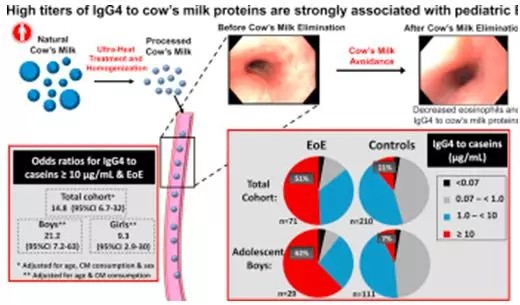JACI :牛奶蛋白特異性IgG4與嗜酸細(xì)胞性食管炎的相關(guān)性
發(fā)布日期:2018-12-10
原標(biāo)題:嗜酸細(xì)胞性食管炎患兒中牛奶特異性IgG4

延伸閱讀
JACI
https://doi.org/10.1016/j.jaci.2018.02.049
Abstract:
Background
Allergen-specific IgG4 (sIgG4) antibodies are often associated with tolerance, but sIgG4 antibodies to causally relevant foods have been reported recently in adults with eosinophilic esophagitis (EoE). Prevalence and levels of food sIgG4 are not well established in the general pediatric population.
Objective
We sought to investigate serum food sIgG4 with component diagnostics in children with EoE and children from an unselected birth cohort and to explore the effects of sex, age, and milk consumption on sIgG4 levels.
Methods
Sera from 71 pediatric patients with EoE and 210 early adolescent children from an unselected birth cohort (Project Viva) were assayed for sIgG4 and specific IgE (sIgE) to major cow's milk (CM) proteins (α-lactalbumin, β-lactoglobulin, and caseins) and to wheat, soy, egg, and peanut proteins.
Results
In the EoE cohort high-titer sIgG4 (≥10 μg/mL) to CM proteins was more common than in control sera and achieved odds ratios for EoE ranging from 5.5 to 8.4. sIgE levels to CM proteins were mostly 4 IU/mL or less in patients with EoE, such that sIgG4/sIgE ratios were often 10,000 or greater. When adjusted for age and milk consumption, high-titer sIgG4 to CM proteins was strongly associated with EoE, with an odds ratio of greater than 20 to all 3 CM proteins in boys.
Conclusions
sIgG4 to CM proteins are common and high titer in children with EoE. Although it is not clear that this response is pathogenic, sIgG4 levels imply that these antibodies are an important feature of the local immune response that gives rise to EoE.
All Authors:
Alexander J.SchuylerBS, BAa?Jeffrey M.WilsonMD, PhDa?AnubhaTripathiMDaScott P.ComminsMD, PhDbPrincess U.OgboguMDcPatrice G.KruzsewskiDOdBarrett H.BarnesMDeEmily C.McGowanMD, PhDaLisa J.WorkmanBAaJonasLidholmPhDfSheryl L.Rifas-ShimanMPHgEmilyOkenMD, MPHgDiane R.GoldMD, MPHhThomas A.E.Platts-MillsMD, PhDa?Elizabeth A.ErwinMDi?


——來自浙大迪迅
?、龠^敏原特異性IgG4 (sIgG4)抗體通常與耐受性有關(guān),但最近有人報道了成人嗜酸細(xì)胞性食管炎(EoE)患者中的病因相關(guān)食物特異性IgG4抗體。一般兒童人群中食物特異性IgG4的水平和流行病學(xué)情況還沒有很好地確定。②我們試圖通過對EoE患兒和未經(jīng)選擇的出生隊列的兒童進(jìn)行組分診斷來研究血清中sIgG4的含量,并探討性別、年齡和牛奶攝入量對sIgG4水平的影響。③來自71例兒童EoE患者和210例未經(jīng)選擇的出生隊列中的青春早期兒童(Viva工程)的血清,測定其以下食物特異性IgG4和特異性IgE的水平:主要牛奶蛋白(α-如白蛋白,β-乳球蛋白,酪蛋白)、小麥、大豆、雞蛋、花生。④在EoE隊列中,出現(xiàn)高滴度(≥10μg /ml)的牛奶蛋白sIgG4的情況比對照組更為普遍,優(yōu)勢比(odds ratios)達(dá)到5.5到8.4不等。在EoE患者中,牛奶蛋白sIgE水平大多為4 IU/mL或更少,因此sIgG4/sIgE的比值通常為10000或更高。根據(jù)年齡和牛奶攝入量進(jìn)行調(diào)整,高滴度牛奶蛋白sIgG4與EoE密切相關(guān),在男孩中,三種牛奶蛋白的優(yōu)勢比均大于20。⑤牛奶蛋白sIgG4在EoE患兒中常見,而且滴度高。雖然還不清楚這種反應(yīng)是否具有致病性,但sIgG4水平表明這些抗體是導(dǎo)致EoE的局部免疫反應(yīng)的一個重要特征。
延伸閱讀
JACI
[IF:13.1]
Specific IgG4 antibodies to cow's milk proteins in pediatric patients with eosinophilic esophagitishttps://doi.org/10.1016/j.jaci.2018.02.049
Abstract:
Background
Allergen-specific IgG4 (sIgG4) antibodies are often associated with tolerance, but sIgG4 antibodies to causally relevant foods have been reported recently in adults with eosinophilic esophagitis (EoE). Prevalence and levels of food sIgG4 are not well established in the general pediatric population.
Objective
We sought to investigate serum food sIgG4 with component diagnostics in children with EoE and children from an unselected birth cohort and to explore the effects of sex, age, and milk consumption on sIgG4 levels.
Methods
Sera from 71 pediatric patients with EoE and 210 early adolescent children from an unselected birth cohort (Project Viva) were assayed for sIgG4 and specific IgE (sIgE) to major cow's milk (CM) proteins (α-lactalbumin, β-lactoglobulin, and caseins) and to wheat, soy, egg, and peanut proteins.
Results
In the EoE cohort high-titer sIgG4 (≥10 μg/mL) to CM proteins was more common than in control sera and achieved odds ratios for EoE ranging from 5.5 to 8.4. sIgE levels to CM proteins were mostly 4 IU/mL or less in patients with EoE, such that sIgG4/sIgE ratios were often 10,000 or greater. When adjusted for age and milk consumption, high-titer sIgG4 to CM proteins was strongly associated with EoE, with an odds ratio of greater than 20 to all 3 CM proteins in boys.
Conclusions
sIgG4 to CM proteins are common and high titer in children with EoE. Although it is not clear that this response is pathogenic, sIgG4 levels imply that these antibodies are an important feature of the local immune response that gives rise to EoE.
All Authors:
Alexander J.SchuylerBS, BAa?Jeffrey M.WilsonMD, PhDa?AnubhaTripathiMDaScott P.ComminsMD, PhDbPrincess U.OgboguMDcPatrice G.KruzsewskiDOdBarrett H.BarnesMDeEmily C.McGowanMD, PhDaLisa J.WorkmanBAaJonasLidholmPhDfSheryl L.Rifas-ShimanMPHgEmilyOkenMD, MPHgDiane R.GoldMD, MPHhThomas A.E.Platts-MillsMD, PhDa?Elizabeth A.ErwinMDi?
2018-11-25 Article
創(chuàng)建過敏性疾病的科研、科普知識交流平臺,為過敏患者提供專業(yè)診斷、治療、預(yù)防的共享平臺。

 杭州浙大迪迅生物基因工程有限公司
杭州浙大迪迅生物基因工程有限公司

